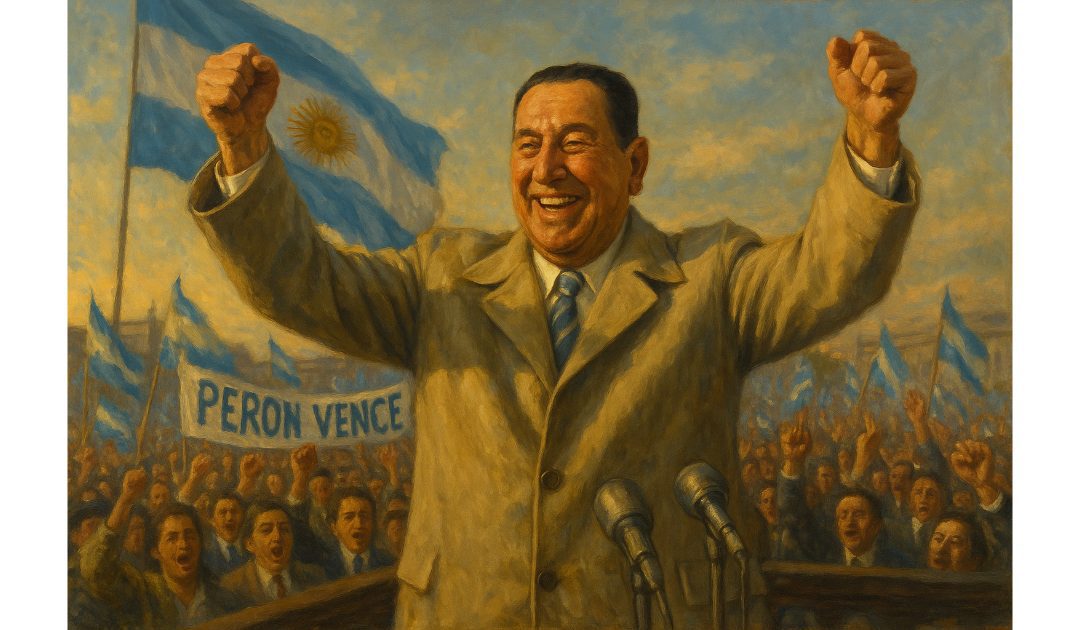I’ve posted about South America a few times, such as Rio de Janeiro and Inca Gold, and here we go again. On the 23rd of September, 1973, a general election in Argentina returned Juan Perón to the presidency for the third time. He was certainly very popular, and for good reason. But there was also a darker side.
Perón’s early life was marked by a military career that shaped his leadership style and political ideology. He graduated from the National Military College in 1913 and steadily rose through the ranks. His time as a military attaché in various European countries during the 1930s exposed him to different governance systems, including Italian fascism and German authoritarianism, which influenced his views on state organisation and social policies.
In 1943, Perón became a key figure in a military coup that ousted the civilian government amidst widespread dissatisfaction with Argentina’s political instability and economic struggles. He was appointed Secretary of Labour and Social Welfare, a position that allowed him to connect directly with the working class. Perón implemented numerous reforms that improved wages, working conditions, and social security, earning him widespread support among labour unions and the working populace.
Perón’s rising popularity alarmed his political opponents, leading to his brief imprisonment in 1945. However, massive demonstrations orchestrated by labour unions, notably the iconic rally in Plaza de Mayo on the 17th of October, 1945, secured his release. This event is commemorated as Loyalty Day, a pivotal moment in Argentine history symbolising the powerful bond between Perón and the working class.
In 1946, Perón was elected President of Argentina with strong backing from the working class and unions. His first term focused on social justice and economic independence, principles central to what became known as Peronism. He nationalised key industries, expanded social welfare programmes, and embarked on ambitious infrastructure projects. His wife, Eva Perón, or “Evita,” played a crucial role in his administration, championing women’s suffrage, social welfare, and the rights of the poor, further solidifying their popularity.
Despite his achievements, Perón’s administration faced criticism for authoritarian tendencies, suppression of dissent, and stringent control over the press. His relationships with the Catholic Church and the military deteriorated over time, leading to political tensions. In 1955, a military coup forced Perón into exile, marking the beginning of a complex period in Argentine politics characterised by fluctuating military and civilian governments and the persistent influence of Peronist ideology.
During his 18-year exile, Perón lived in various countries, including Spain, maintaining contact with his supporters in Argentina. His ideological legacy endured, influencing political discourse and movements across the spectrum. In 1973, amid political turmoil and economic challenges, Perón returned to Argentina and was re-elected President. His third term, however, was brief and tumultuous, marked by internal conflicts within the Peronist movement and economic difficulties. Perón passed away on the 1st of July, 1974, leaving his third wife, Isabel Perón, as his successor.
Perón’s political ideology, known as Justicialism or Peronism, is a unique blend of populism, nationalism, and social justice. It emphasises the role of the state in regulating the economy, protecting workers’ rights, and promoting social welfare. Peronism transcends traditional political divisions, appealing to diverse groups and evolving over time to encompass both left-wing and right-wing elements.
Juan Perón’s legacy is complex and multifaceted. He is celebrated for his contributions to social justice and the empowerment of the working class, but also criticised for his authoritarian methods and political repression. Peronism remains a dominant force in Argentine politics, influencing successive generations of leaders and shaping the nation’s identity.
Perón’s life and career encapsulate the dynamic interplay between leadership, ideology, and popular movements. His impact on Argentina continues to be felt, reflecting the enduring resonance of his vision for social justice, economic sovereignty, and political participation. His story is not merely a chapter in Argentina’s history but an ongoing narrative that shapes the country’s political landscape to this day.

